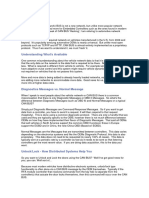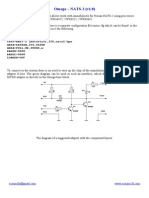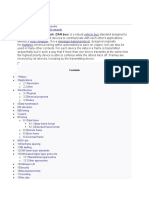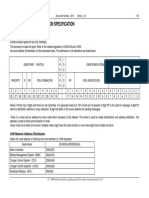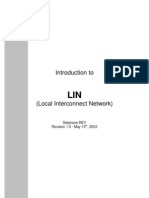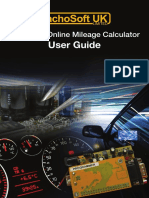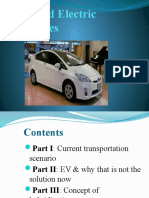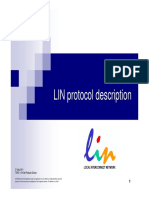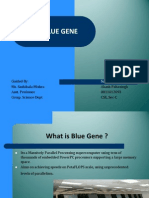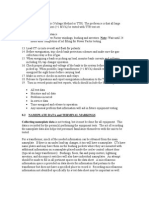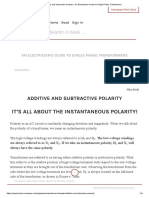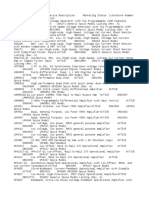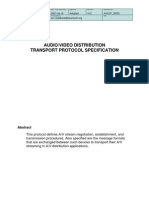NI Tutorial 2732 en
NI Tutorial 2732 en
Uploaded by
manumanu12Copyright:
Available Formats
NI Tutorial 2732 en
NI Tutorial 2732 en
Uploaded by
manumanu12Original Title
Copyright
Available Formats
Share this document
Did you find this document useful?
Is this content inappropriate?
Copyright:
Available Formats
NI Tutorial 2732 en
NI Tutorial 2732 en
Uploaded by
manumanu12Copyright:
Available Formats
Document Type: Tutorial NI Supported: Yes Publish Date: Nov 30, 2011
Controller Area Network (CAN) Overview
Table of Contents 1. 2. 3. 4. 5. 6. 7. 8. 9. 10. CAN History CAN Benefits CAN Applications CAN Physical Layers CAN Terminology CAN Database Files How CAN Communication Works National Instruments CAN Tools NI-XNET Software Driver NI-CAN Software Driver
CAN History Bosch originally developed the Controller Area Network (CAN) in 1985 for in-vehicle networks. In the past, automotive manufacturers connected electronic devices in vehicles using point-to-point wiring systems. Manufacturers began using more and more electronics in vehicles, which resulted in bulky wire harnesses that were heavy and expensive. They then replaced dedicated wiring with in-vehicle networks, which reduced wiring cost, complexity, and weight. CAN, a high-integrity serial bus system for networking intelligent devices, emerged as the standard in-vehicle network. The automotive industry quickly adopted CAN and, in 1993, it became the international standard known as ISO 11898. Since 1994, several higher-level protocols have been standardized on CAN, such as CANopen and DeviceNet. Other markets have widely adopted these additional protocols, which are now standards for industrial communications. This white paper focuses on CAN as an in-vehicle network. CAN Benefits Low-Cost, Lightweight Network CAN provides an inexpensive, durable network that helps multiple CAN devices communicate with one another. An advantage to this is that electronic control units (ECUs) can have a single CAN interface rather than analog and digital inputs to every device in the system. This decreases overall cost and weight in automobiles. Broadcast Communication Each of the devices on the network has a CAN controller chip and is therefore intelligent. All devices on the network see all transmitted messages. Each device can decide if a message is relevant or if it should be filtered. This structure allows modifications to CAN networks with minimal impact. Additional non-transmitting nodes can be added without modification to the network. Priority Every message has a priority, so if two nodes try to send messages simultaneously, the one with the higher priority gets transmitted and the one with the lower priority gets postponed. This arbitration is non-destructive and results in non-interrupted transmission of the highest priority message. This also allows networks to meet deterministic timing constraints. Error Capabilities The CAN specification includes a Cyclic Redundancy Code (CRC) to perform error checking on each frame's contents. Frames with errors are disregarded by all nodes, and an error frame can be transmitted to signal the error to the network. Global and local errors are differentiated by the controller, and if too many errors are detected, individual nodes can stop transmitting errors or disconnect itself from the network completely.
Figure 1. CAN networks significantly reduce wiring.
CAN Applications CAN was first created for automotive use, so its most common application is in-vehicle electronic networking. However, as other industries have realized the dependability and advantages of CAN over the past 20 years, they have adopted the bus for a wide variety of applications. Railway applications such as streetcars, trams, undergrounds, light railways, and long-distance trains incorporate CAN. You can find CAN on different levels of the multiple networks within these vehicles for example, in linking the door units or brake controllers, passenger counting units, and more. CAN also has applications in aircraft with flight-state sensors, navigation systems, and research PCs in the cockpit. In addition, you can find CAN buses in many aerospace applications, ranging from in-flight data analysis to aircraft engine control systems such as fuel systems, pumps, and linear actuators. Medical equipment manufacturers use CAN as an embedded network in medical devices. In fact, some hospitals use CAN to manage complete operating rooms. Hospitals control operating room components such as lights, tables, cameras, X-ray machines, and patient beds with CAN-based systems. Lifts and escalators use embedded CAN networks, and hospitals use the CANopen protocol to link lift devices, such as panels, controllers, doors, and light barriers, to each other and control them. CANopen also is used in nonindustrial applications such as laboratory equipment, sports cameras, telescopes, automatic doors, and even coffee machines. CAN Physical Layers
1/5
www.ni.com
CAN has several different physical layers you can use. These physical layers classify certain aspects of the CAN network, such as electrical levels, signaling schemes, cable impedance, maximum baud rates, and more. The most common and widely used physical layers are described below: High-Speed CAN High-speed CAN is by far the most common physical layer. High-speed CAN networks are implemented with two wires and allow communication at transfer rates up to 1 Mbit/s. Other names for high-speed CAN include CAN C and ISO 11898-2. Typical high-speed CAN devices include antilock brake systems, engine control modules, and emissions systems. Low-Speed/Fault-Tolerant CAN Hardware Low-speed/fault-tolerant CAN networks are also implemented with two wires, can communicate with devices at rates up to 125 kbit/s, and offer transceivers with fault-tolerant capabilities. Other names for low-speed/fault-tolerant CAN include CAN B and ISO 11898-3. Typical low-speed/fault-tolerant devices in an automobile include comfort devices. Wires that have to pass through the door of a vehicle are low-speed/fault-tolerant in light of the stress that is inherent to opening and closing a door. Also, in situations where an advanced level of security is desired, such as with brake lights, low-speed/fault-tolerant CAN offers a solution. Single-Wire CAN Hardware Single-wire CAN interfaces can communicate with devices at rates up to 33.3 kbit/s (88.3 kbit/s in high-speed mode). Other names for single-wire CAN include SAE-J2411, CAN A, and GMLAN. Typical single-wire devices within an automobile do not require high performance. Common applications include comfort devices such as seat and mirror adjusters. Software-Selectable CAN Hardware With National Instruments CAN hardware products, you can configure the software-selectable CAN interfaces to use any of the onboard transceivers (high-speed, low-speed/fault-tolerant, or single-wire CAN). Multiple-transceiver hardware offers the perfect solution for applications that require a combination of communications standards. With software-selectable CAN hardware, you also can choose your own external CAN transceiver. CAN Terminology CAN devices send data across the CAN network in packets called frames. A CAN frame consists of the following sections. CAN Frame -- an entire CAN transmission: arbitration ID, data bytes, acknowledge bit, and so on. Frames also are referred to as messages.
Figure 2. The standard CAN frame format. SOF (start-of-frame) bit indicates the beginning of a message with a dominant (logic 0) bit. Arbitration ID identifies the message and indicates the message's priority. Frames come in two formats -- standard, which uses an 11-bit arbitration ID, and extended, which uses a 29-bit arbitration ID. IDE (identifier extension) bit allows differentiation between standard and extended frames. RTR (remote transmission request) bit serves to differentiate a remote frame from a data frame. A dominant (logic 0) RTR bit indicates a data frame. A recessive (logic 1) RTR bit indicates a remote frame. DLC (data length code) indicates the number of bytes the data field contains. Data Field contains 0 to 8 bytes of data. CRC (cyclic redundancy check) contains 15-bit cyclic redundancy check code and a recessive delimiter bit. The CRC field is used for error detection. ACK (ACKnowledgement) slot any CAN controller that correctly receives the message sends an ACK bit at the end of the message. The transmitting node checks for the presence of the ACK bit on the bus and reattempts transmission if no acknowledge is detected. National Instruments Series 2 CAN interfaces have the capability of listen-only mode. Herein, the transmission of an ACK bit by the monitoring hardware is suppressed to prevent it from affecting the behavior of the bus. CAN Signal an individual piece of data contained within the CAN frame data field. You also can refer to CAN signals as channels. Because the data field can contain up to 8 bytes of data, a single CAN frame can contain 0 to 64 individual signals (for 64 channels, they would all be binary). In the following image, there are six channels contained in the data field of a single CAN frame. Each signal contains 8 bits of data.
Figure 3. Signals can be defined as a certain number of bits inside of a CAN frame.
CAN Database Files CAN database files are text files that contain scaling information for CAN frames and signal definitions. National Instruments NI-XNET database editor software recognizes FIBEX database files (.xml), Vector database files (*.dbc), and National Instruments CAN database files (*.ncd). For each signal, CAN databases define rules for conversion to engineering units. The following data is stored in databases: Channel name Location (start bit) and size (number of bits) of the channel within a given message Byte order (Intel/Motorola) Data type (signed, unsigned, and IEEE float) Scaling and units string Range
2/5
www.ni.com
Range Default value Comment You can use this information to easily convert the "raw" frame information (usually bytes) to a "real world" value. The picture below illustrates an example of this conversion.
Figure 4. All of the necessary scaling data is contained in a database for converting frames to signals. CAN database files may contain frame and signal definitions for an entire vehicle. Every network has its own unique database file. Additionally, these database files are vendor-specific and usually confidential. By using a database file for many frames on the CAN network, many CAN APIs (like NI-XNET) can automatically convert the frame information directly to a real-world value. This simplifies application development because you never need to worry about the raw frame values. How CAN Communication Works As stated earlier, CAN is a peer-to-peer network. This means that there is no master that controls when individual nodes have access to read and write data on the CAN bus. When a CAN node is ready to transmit data, it checks to see if the bus is busy and then simply writes a CAN frame onto the network. The CAN frames that are transmitted do not contain addresses of either the transmitting node or any of the intended receiving node(s). Instead, an arbitration ID that is unique throughout the network labels the frame. All nodes on the CAN network receive the CAN frame, and, depending on the arbitration ID of that transmitted frame, each CAN node on the network decides whether to accept the frame. If multiple nodes try to transmit a message onto the CAN bus at the same time, the node with the highest priority (lowest arbitration ID) automatically gets bus access. Lower-priority nodes must wait until the bus becomes available before trying to transmit again. In this way, you can implement CAN networks to ensure deterministic communication among CAN nodes.
Figure 5. CAN contains built in priority for messages to avoid conflicts. National Instruments CAN Tools National Instruments provides a variety of hardware and software tools for CAN application development. NI offers CAN interfaces for different platforms including PCI, PXI, USB, PCMCIA, NI CompactRIO, and NI CompactDAQ. For PCI, PXI, NI CompactDAQ, NI CompactRIO, and PCMCIA, you can choose from high-speed, low-speed/fault-tolerant, and single-wire physical layers. For PCI and PXI, National Instruments provides the industry's first software-selectable CAN interface that contains a high-speed, low-speed/fault-tolerant, and single-wire transceiver on each board, for each port, on a single device. This means you can simply select in your software which mode you want to use.
3/5
www.ni.com
Figure 6. NI PCI-8513 Software-Selectable (XS) CAN Device
In addition, NI ships each of these devices with the appropriate driver software. NI CAN interface driver software is described below.
The National Instruments ECU Measurement and Calibration Toolkit extends the NI LabVIEW, NI LabWindows/CVI, and C/C++ development environments to support measurement and calibration applications for the design and validation of electronic control units (ECUs). The ECU Measurement and Calibration Toolkit provides high-level, easy-to-use functions based on the CAN Calibration Protocol (CCP) that ECU designers, testers, and engineers can use to build their own customized measurement and calibration applications. For more information, visit the ECU Measurement and Calibration Toolkit resource below. See Also NI Controller Area Network (CAN) Interfaces (PCI) NI Controller Area Network (CAN) Interfaces (PXI) NI Controller Area Network (CAN) Interfaces (NI CompactDAQ) NI Controller Area Network (CAN) Interfaces (NI CompactRIO) NI Controller Area Network (CAN) Interfaces (USB) NI Controller Area Network (CAN) Interfaces (PCMCIA) NI ECU Measurement and Calibration Toolkit NI-XNET Software Driver NI-XNET software is included with PCI/PXI-851x and NI 986x devices and is available as a free download on ni.com. This new driver is used to develop CAN, local interconnect network (LIN), and FlexRay applications in NI LabVIEW, NI LabWindows/CVI, and C/C++ on Windows and LabVIEW Real-Time OSs. As part of the NI-XNET platform, NI 851x and NI 986x devices work well for applications requiring real-time, high-speed manipulation of hundreds of frames and signals, such as hardware-in-the-loop simulation, rapid control prototyping, bus monitoring, automation control, and more. NI-XNET: One API, Many Embedded Networks The NI-XNET platform combines a series of high-performance CAN, LIN, and FlexRay interfaces with the NI-XNET API, a common set of easy-to-use functions for reading and writing CAN, LIN, and FlexRay frames and signals. Top Performance With Less Programming NI-XNET interfaces bring together the performance associated with low-level microcontroller programming and the speed and power of Windows and LabVIEW Real-Time OS development. The patent-pending NI-XNET device-driven DMA engine reduces system latency, a common pain point for PC-based CAN interfaces, from milliseconds to microseconds. The engine enables the onboard processor to move CAN frames and signals between the interface and the user program without CPU interrupts, freeing host processor time for processing complex models and applications. NI-CAN Software Driver National Instruments includes NI-CAN driver software with all National Instruments Legacy CAN interfaces and provides it as a free software download on ni.com. With other CAN interfaces, you can take advantage of only a small percentage of the board functionality if you do not purchase the turnkey software tool. However, all of the National Instruments CAN board functionality is fully exposed, so you can develop your own custom-defined applications in the programming language of your choice. The NI-CAN driver provides high-level, easy-to-use functions to help you develop
4/5
www.ni.com
entire CAN applications quickly, saving you both time and money. There are two APIs exposed with the NI-CAN driver software. The Frame API is the original API for CAN programming. In the Frame API, you can transmit and receive CAN frames that contain raw data bytes. Your program must parse and scale these bytes to come up with scaled engineering units. For more information on programming with the Frame API, view the "Using the Frame API" section of the NI CAN Hardware and Software Manual (see below). NI first introduced the Channel API in the NI-CAN 2.0 driver software. You can read from and write to CAN channels using channel names defined in database files (.dbc or .ncd). The Channel API provides the following benefits: High-level programming Easy-to-use physical units Primary use for easy CAN/data acquisition synchronization Ability to incorporate Vector database files For more information on programming with the Channel API, see the NI-CAN Channel API resource below. See Also Download the latest National Instruments CAN Software The NI-CAN Channel API NI CAN Hardware and Software Manual Related Links National Instruments Controller Area Network (CAN) Home Page Synchronizing CAN and Analog Signals for Device Validation
The mark LabWindows is used under a license from Microsoft Corporation. Windows is a registered trademark of Microsoft Corporation in the United States and other countries.
Legal This tutorial (this "tutorial") was developed by National Instruments ("NI"). Although technical support of this tutorial may be made available by National Instruments, the content in this tutorial may not be completely tested and verified, and NI does not guarantee its quality in any way or that NI will continue to support this content with each new revision of related products and drivers. THIS TUTORIAL IS PROVIDED "AS IS" WITHOUT WARRANTY OF ANY KIND AND SUBJECT TO CERTAIN RESTRICTIONS AS MORE SPECIFICALLY SET FORTH IN NI.COM'S TERMS OF USE ( http://ni.com/legal/termsofuse/unitedstates/us/).
5/5
www.ni.com
You might also like
- Iso 17987-2-2016Document82 pagesIso 17987-2-2016Thibaud Rouillé100% (1)
- CANBUS InfoDocument19 pagesCANBUS InfoBenito Camela100% (1)
- Nats-2 EngDocument3 pagesNats-2 EngkrakhosNo ratings yet
- CAN-bus InterfaceDocument2 pagesCAN-bus Interfacemohamed abd el razek0% (1)
- NR Can System Engineering 140107Document2 pagesNR Can System Engineering 140107Daniel CarmonaNo ratings yet
- Fuling DZB200 - DZB300 Inverter User Manual PDFDocument54 pagesFuling DZB200 - DZB300 Inverter User Manual PDFayman emmad100% (1)
- Project ThesisDocument54 pagesProject ThesisIrelyn100% (1)
- SW-HF 5.1 4500 SERVICE GUIDE - PDF - GeniusDocument33 pagesSW-HF 5.1 4500 SERVICE GUIDE - PDF - GeniusytrisNo ratings yet
- 01 ETR300R Manual Control Ver1.47 201304Document313 pages01 ETR300R Manual Control Ver1.47 201304chiemenx100% (1)
- Controller Area Network (CAN)Document10 pagesController Area Network (CAN)api-3754722100% (3)
- Implementation of CAN Bus in An Autonomous All-Terrain VehicleDocument14 pagesImplementation of CAN Bus in An Autonomous All-Terrain VehiclePradeep CheekatlaNo ratings yet
- The Controller Area NetworkDocument70 pagesThe Controller Area NetworkRAJI00675% (4)
- CAN Bus: Jump To Navigation Jump To Search Vehicle Bus Microcontrollers Host Computer Message-Based Protocol MultiplexDocument25 pagesCAN Bus: Jump To Navigation Jump To Search Vehicle Bus Microcontrollers Host Computer Message-Based Protocol MultiplexBenjamin HouseNo ratings yet
- The CAN BusDocument3 pagesThe CAN BusaknabcdNo ratings yet
- At91sam7 - CanDocument58 pagesAt91sam7 - Cangopismiles1987No ratings yet
- Thomson Electrac HD Linear Actuator Motion Control per CAN BusFrom EverandThomson Electrac HD Linear Actuator Motion Control per CAN BusNo ratings yet
- Automotive BasicsDocument73 pagesAutomotive BasicsgvcsvgNo ratings yet
- Can BusDocument19 pagesCan BusVipin JainNo ratings yet
- GT-POWER Engine Simulation Software: HighlightsDocument2 pagesGT-POWER Engine Simulation Software: HighlightsIrfan ShaikhNo ratings yet
- FlexRay Network For Motor VehiclesDocument14 pagesFlexRay Network For Motor Vehiclesrohit.chakravarthy4637100% (1)
- CANalyzer75 Manual enDocument148 pagesCANalyzer75 Manual enAlfredoNo ratings yet
- Applications: AutomotiveDocument8 pagesApplications: AutomotiveMohammad FaizalNo ratings yet
- CAN Newsletter: Hardware + Software + Tools + EngineeringDocument42 pagesCAN Newsletter: Hardware + Software + Tools + EngineeringAlex DinuNo ratings yet
- CAN Bus Communication SpecDocument7 pagesCAN Bus Communication SpecMiguel Martin0% (1)
- In Vehicle NetworkingDocument5 pagesIn Vehicle NetworkingRana PrataapNo ratings yet
- NetworkDesigner22 LIN Manual enDocument72 pagesNetworkDesigner22 LIN Manual enTeodorescu MihailNo ratings yet
- Data Line - BCM Control SchematicsDocument24 pagesData Line - BCM Control Schematicsdldever01No ratings yet
- Automotive ElectronicsDocument100 pagesAutomotive ElectronicsanushkaNo ratings yet
- CAN (Control Area Network)Document18 pagesCAN (Control Area Network)Lee Răng HôNo ratings yet
- Controller Area NetworkDocument20 pagesController Area NetworkbonthanagabhushanamNo ratings yet
- Can Interview Questions: 1. What Is CAN? Answer: 1. CAN Is A Multi Master Broadcast Serial Bus Standard For Connecting Electronic ControlDocument59 pagesCan Interview Questions: 1. What Is CAN? Answer: 1. CAN Is A Multi Master Broadcast Serial Bus Standard For Connecting Electronic Controlboobalkrishnan2576No ratings yet
- DiagnosticsDocument30 pagesDiagnosticsDivakar ReddyNo ratings yet
- Sae j1962 1995 PDFDocument8 pagesSae j1962 1995 PDFmiguelcastilloNo ratings yet
- NTC Automotive Sensors PBDocument6 pagesNTC Automotive Sensors PBMuhamed Abd ElrazekNo ratings yet
- CANalyzer - Canopen DataSheet enDocument4 pagesCANalyzer - Canopen DataSheet enFerdinand VelokurckiNo ratings yet
- Diganostcs For Automobiles-A SnapshotDocument8 pagesDiganostcs For Automobiles-A SnapshotZeljkoSipcicNo ratings yet
- Chapter 4 Accessing The CAN Bus NewDocument8 pagesChapter 4 Accessing The CAN Bus NewLizien Wild EngineNo ratings yet
- Understanding and Using The CAN-1Document41 pagesUnderstanding and Using The CAN-1mail87523No ratings yet
- Conf08presentation SMDocument333 pagesConf08presentation SMVASEKNo ratings yet
- Secondary Air Injection (AIR) System MonitorDocument3 pagesSecondary Air Injection (AIR) System MonitorJosé AntonioNo ratings yet
- Introduction To LIN (Local Interconnect Network)Document11 pagesIntroduction To LIN (Local Interconnect Network)digitales100% (6)
- Automotive Electrical and Electronic SystemsDocument4 pagesAutomotive Electrical and Electronic SystemsVikram Athreya VNo ratings yet
- CAN ProtocolDocument9 pagesCAN Protocolhaythem.mejri.proNo ratings yet
- Obd Ii Pids: From Wikipedia, The Free EncyclopediaDocument18 pagesObd Ii Pids: From Wikipedia, The Free EncyclopediacocorocaraNo ratings yet
- CAN Mode 6Document12 pagesCAN Mode 6Abdulbaset Selwy100% (1)
- Flash en Flex Ray ElektronikAutomotive 200711 Press Article enDocument15 pagesFlash en Flex Ray ElektronikAutomotive 200711 Press Article ensureshadroitNo ratings yet
- User Guide: Tachosoft Online Mileage CalculatorDocument22 pagesUser Guide: Tachosoft Online Mileage CalculatorMarcelo DecimaNo ratings yet
- Boost Pressure Sensor (BPS)Document50 pagesBoost Pressure Sensor (BPS)Gian Fran0% (1)
- Automotive GuideDocument25 pagesAutomotive GuidearnaldospbrNo ratings yet
- FAQ Install An eCOM PartP Interface With DTS V8.06Document5 pagesFAQ Install An eCOM PartP Interface With DTS V8.06Dylan DYNo ratings yet
- Hybrid VehiclesDocument20 pagesHybrid VehiclesThulasi RamNo ratings yet
- ASORO AUTOMOBILE CONSULTANCY BooksDocument44 pagesASORO AUTOMOBILE CONSULTANCY BooksFernando CarlosNo ratings yet
- Remote Diagnostic SystemDocument14 pagesRemote Diagnostic SystemBoopathirajaNo ratings yet
- Unit 2-AEEDocument128 pagesUnit 2-AEEChidananda BasavannaNo ratings yet
- LH Kwp2000 Flashen v1.1 enDocument36 pagesLH Kwp2000 Flashen v1.1 enArda AkberkNo ratings yet
- End To End Information About CANBUSDocument18 pagesEnd To End Information About CANBUSjasmine100% (2)
- Automotive Radar - Waveform Design PrinciplesDocument4 pagesAutomotive Radar - Waveform Design PrinciplesAarav K SNo ratings yet
- Lin ProtocolDocument46 pagesLin Protocoltrotraran100% (1)
- Plug-In Hybrid Electric Vehicles The Ultimate Step-By-Step GuideFrom EverandPlug-In Hybrid Electric Vehicles The Ultimate Step-By-Step GuideNo ratings yet
- Diagnostic Communication with Road-Vehicles and Non-Road Mobile MachineryFrom EverandDiagnostic Communication with Road-Vehicles and Non-Road Mobile MachineryRating: 1 out of 5 stars1/5 (1)
- CAN and FPGA Communication Engineering: Implementation of a CAN Bus based Measurement System on an FPGA Development KitFrom EverandCAN and FPGA Communication Engineering: Implementation of a CAN Bus based Measurement System on an FPGA Development KitNo ratings yet
- Ac 2007-2855: Pscad Simulation in A Power Electronics Application CourseDocument9 pagesAc 2007-2855: Pscad Simulation in A Power Electronics Application CourseMayur ChavdaNo ratings yet
- Amc7135 Led Driver DatasheetDocument6 pagesAmc7135 Led Driver DatasheetJose BenavidesNo ratings yet
- Manual Code 300Document80 pagesManual Code 300Pablo SanchezNo ratings yet
- Electronics & Communication EngineeringDocument242 pagesElectronics & Communication EngineeringRUFUS SHAJINo ratings yet
- OBDII J1708/J1587 Simulator: FeaturesDocument12 pagesOBDII J1708/J1587 Simulator: FeaturesLimbert ToledoNo ratings yet
- HVDC Transmission Using Voltage Source Converters (VSC)Document10 pagesHVDC Transmission Using Voltage Source Converters (VSC)kanthbcNo ratings yet
- Recruitment AE Poster SoCtronicsDocument1 pageRecruitment AE Poster SoCtronicspolumanohar6No ratings yet
- Item # Manufacturer Ref Des Qty MFG Part #: XXXX XXXX XXXXX Xxpcs Bom (Sample Bill of Materials)Document3 pagesItem # Manufacturer Ref Des Qty MFG Part #: XXXX XXXX XXXXX Xxpcs Bom (Sample Bill of Materials)KenrickNo ratings yet
- Neopis Frtu For LBS, Sectionalizer Epic-D300 Cat v2.4Document10 pagesNeopis Frtu For LBS, Sectionalizer Epic-D300 Cat v2.4Ngoc QuyenNo ratings yet
- VM-Q401A CCTV Color Quad Processor: User's ManualDocument15 pagesVM-Q401A CCTV Color Quad Processor: User's ManualYuan SupriyantoNo ratings yet
- Are Co-Operatives Relevant in Today's Global Environment - Group DiscussionDocument6 pagesAre Co-Operatives Relevant in Today's Global Environment - Group DiscussiongvcNo ratings yet
- M Ge PSW Pse 01Document1 pageM Ge PSW Pse 01Bob YuNo ratings yet
- How To Sell Hillstone 301. A Series NGFW v5.5r9Document48 pagesHow To Sell Hillstone 301. A Series NGFW v5.5r9Elvis da Silva SalesNo ratings yet
- Management Interface For SFP+: Published SFF-8472 Rev 12.4Document43 pagesManagement Interface For SFP+: Published SFF-8472 Rev 12.4Антон ЛузгинNo ratings yet
- IBM Blue Gene SupercomputerDocument21 pagesIBM Blue Gene SupercomputerAkash PaltasinghNo ratings yet
- Transformer Testing 3Document1 pageTransformer Testing 3imcoolmailme2No ratings yet
- Low Frequency AC Transmission For Offshore Wind PowerDocument6 pagesLow Frequency AC Transmission For Offshore Wind PowerWARSE JournalsNo ratings yet
- Marantz PM-15S1K1G Service ManualDocument51 pagesMarantz PM-15S1K1G Service ManualBon BencavNo ratings yet
- Additive and Subtractive Polarity - An Electrician's Guide To Single Phase TransformersDocument4 pagesAdditive and Subtractive Polarity - An Electrician's Guide To Single Phase TransformersDeoudrafNo ratings yet
- Fluid Logic Control SystemsDocument9 pagesFluid Logic Control SystemsM RazzaqueNo ratings yet
- Lorawan Gateway Project ReportDocument62 pagesLorawan Gateway Project ReportSonu NagvanshiNo ratings yet
- Ti Spice Models IndexDocument2 pagesTi Spice Models IndexVarun Sundar0% (1)
- Tecnica Plasma 18-31 PDFDocument20 pagesTecnica Plasma 18-31 PDFсергей васяновичNo ratings yet
- Avdtp Spec v12Document131 pagesAvdtp Spec v12Gokhan Tanyeri100% (1)
- SM-A217F Galaxy A21sDocument11 pagesSM-A217F Galaxy A21sBang MoSuNo ratings yet
- Cia Test - 1 Mark Detail: All Pass PercentageDocument3 pagesCia Test - 1 Mark Detail: All Pass PercentageAnbalagan GuruNo ratings yet


